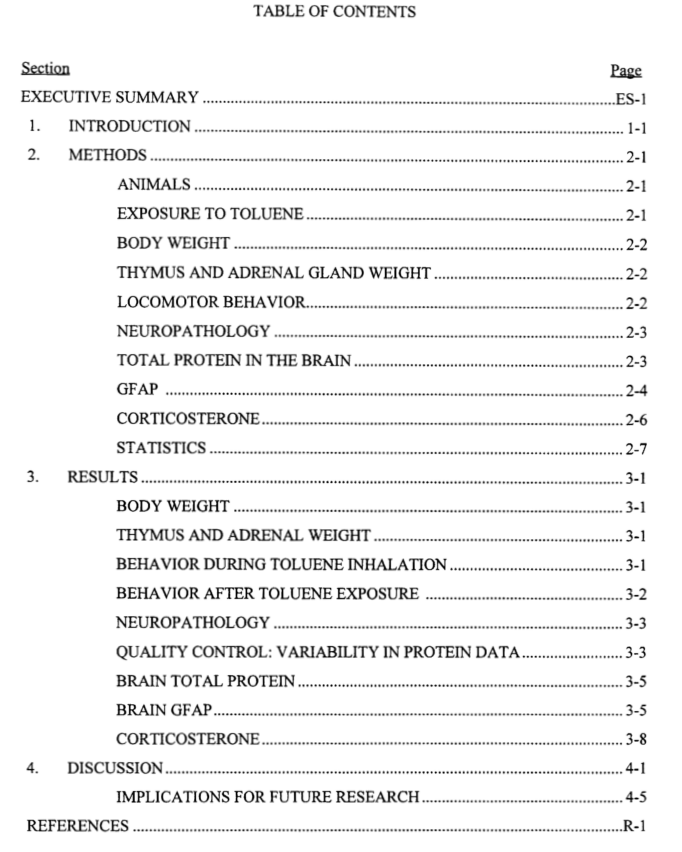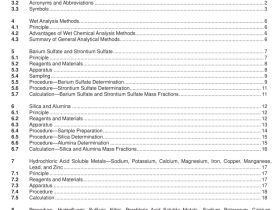API Publ 4647 pdf download

API Publ 4647 pdf download BRAIN GLIAL FIBRILLARYAcIDIC PROTEIN (GFAP)AS A MARKER OF NEUROTOXICITY DURINGINHALATION EXPOSURETO TOLUENE
ANIMALS
Male F344 rats (Taconic Farms, Germantown, NY), weighing 76 to 100 g (age 40 days) uponarrival in the lab, were housed in pairs in plastic shoe box cages (25.9 cm W x 46.9Lx 20.8 H)with wood chips as bedding and ad lib access to tap water and to food (Rodent Laboratory Chow5001″, Ralston Purina Corp., St. Louis,MO). Before toluene exposure began, rats were
quarantined for 7 days, weighed and observed to ensure health and to determine baselines.Priorto each toluene exposure session, animals are transferred from home cages to stainless steel meshexposure cages.Food and water are not available during inhalation exposures so as to preventuncontrolled exposure by the oral route. This research was approved by the institutional animalcare and use committee and conformed to the current animal care guidelines of state and federalagencies.
EXPOSURE TO TOLUENE
Groups of up to 32 rats were exposed to 0 ppm (conditioned air) or toluene (100,300, 1,000 and3,000 ppm) in dynamic exposure chambers, 6 hr daily, Monday through Friday. This exposureschedule was planned to simulate an occupational exposure. Inhalation exposures are conductedin either 1.3 or 0.13 m3stainless steel chambers.Control rats were exposed in separate
chambers to filtered, conditioned air concurrently with the toluene groups.Control animals arehoused and transported separately from test animals, to prevent unplanned exposure of controlanimals to experimental compounds which may linger in the fur or other body constituents of testanimals.
Chamber atmospheres were maintained as described in published work (Dempster et al.,1984).In brief, high concentrations of solvent atmospheres are generated by first producing an aerosolof the solvent by means of a Laskin nebulizer, and then feeding the aerosol into a heated vesselto vaporize the solvent droplets. Low concentrations of solvent are generated by passing an air stream over the surface of the liquid solvent and feeding the resultant solvent-laden air into thechamber. Reagent grade toluene was provided by the API.
Concentration of toluene in the test chamber, determined by infrared analyzer (MIRAN/IACVFR,Foxboro Analytical, So. Norwalk,CT), using a 9.8 micron wavelength, was compared to the
nominal chamber concentration determined from the total volume of toluene used each day foreach chamber.Chamber atmospheres, temperature and relative humidity measurements aretaken at 30 min intervals during the daily exposures. Mean toluene exposures were kept within±10% of the nominal concentration.
BoDY WEIGHT
Body weight was determined in the afternoon, when the rats were removed from the inhalationexposure, using a digital integrating balance(SartoriusR# 1403-MPZ, Sybron/Brinkmann Co.,Westbury, NY ) with an accuracy of±0.1 gas described by Evans et al., 1986.
THYMUS AND ADRENAL GLAND WEIGHT
Rats exposed to 1,000 ppm toluene had their adrenal and thymus glands removed when
decapitated after 3 or 7 days exposure. The wet weight was recorded, then expressed as a ratio tothe body weight.
LOCOMOTOR BEHAVIOR
Behavior of pairs of rats was measured in their home cage, after the conclusion of a 5-day weekof daily toluene inhalation exposures, and inside the inhalation chamber, during selectedexposures to toluene or filtered air. Behavior was automatically measured by a computer atregular intervals using a system of photocells surrounding the cage (Evans et al.,1986; Evans,1989). The post-exposure studies used a stainless steel mesh home cage (17.8 cm W x 30.0L×20.3 H; Evans et al.,1986) and recorded locomotion and rearing separately.During inhalationexposure, it was possible to record only a single index, a composite of total locomotor behavior,because less equipment could be fitted around the inhalation holding cage (stainless mesh
21.6 cm W x 27.9 L x 20.8 H). Measurement of behavior during inhalation exposure was done only for O, 1 O0 and 300 ppm exposures because the behavioral effects of 2 1,000 ppm toluene have already been reported (Wood, 1994). These behavioral measurements are quite similar to those of the EPA Neurotoxicity Guidelines for motor activity (USEPA, 199 i), except that this study’s data consisted of the total activity produced by each pair of rats inside each cage.









